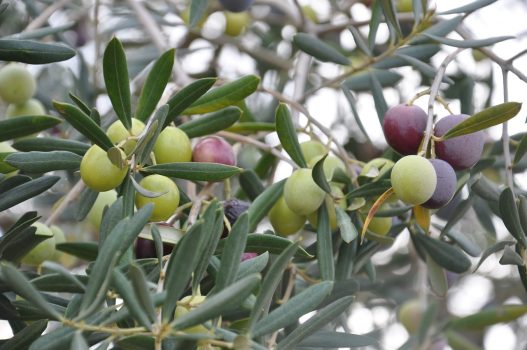Olives, scientifically known as Olea europaea, are among the most ancient fruits cultivated by humanity. Their legacy spans thousands of years, rooted deeply in the Mediterranean Basin, where they have thrived due to the region’s ideal climate. This humble fruit has grown to become an integral part of Mediterranean culture, cuisine, and economy, symbolizing more than just a source of sustenance.
 Pin
Pin Image from Pixabay
One of the fascinating aspects of olives is their remarkable diversity in flavor, nutrition, and appearance. They come in a range of colors—from the bright green of young olives to the deep black of fully ripened ones. Each variety offers a unique taste, texture, and aroma, making olives a versatile addition to countless recipes.
However, the significance of olives extends far beyond the dinner plate. Olives have been celebrated in art, religion, and medicine throughout history. They have been depicted as symbols of peace and prosperity in ancient texts and paintings. In medicine, olives and their oil have been used for centuries to heal wounds, nourish the skin, and promote overall health. Their enduring legacy speaks to their unmatched importance in human history.
Table of Contents
Historical Roots of Olives
 Pin
Pin Image by Ferdaousrez via Wikimedia Commons
The history of olives is as rich as the golden oil they produce. Olives have been cultivated for over 6,000 years, with their origins tracing back to the Eastern Mediterranean. They quickly became a cornerstone of ancient societies, influencing cultural practices, trade, and agriculture.
Ancient Egyptians were among the first civilizations to cultivate olives. Olive oil was not only a dietary staple but also played a critical role in their embalming rituals, symbolizing purity and preservation. The oil was also used to fuel lamps, providing light in temples and homes.
The Greeks regarded the olive tree as sacred, associating it with their mythology. According to legend, the goddess Athena gifted the olive tree to humanity, which is why the city of Athens was named in her honor. The tree’s fruits and oil were so valuable that they were used in religious ceremonies, athletic events, and daily life.
Romans took olive cultivation to new heights, expanding it throughout their empire. They refined methods of harvesting, oil extraction, and storage, ensuring that olives could be transported and traded across vast distances. In Roman times, olive oil became a form of currency, valued as highly as gold, and was used for everything from cooking to skincare.
The journey of olives across civilizations highlights their incredible adaptability and importance. From the deserts of Egypt to the olive groves of Italy, this fruit has left an indelible mark on human history.
Types of Olives
The world of olives is as diverse as the regions they grow in, with each type offering its own distinctive flavor, texture, and culinary possibilities. Here are some of the most popular varieties that have delighted taste buds for centuries:
 Pin
Pin Image by Giancarlo Dessì via Wikimedia Commons
Green Olives: These are harvested before they ripen, giving them a firm texture and a mildly bitter taste. Green olives are often brined or stuffed with ingredients like pimentos, garlic, or almonds, making them a popular choice for appetizers and cocktails, such as martinis.
 Pin
Pin Image by Aracuano via Wikimedia Commons
Black Olives: Fully ripened olives, black varieties are known for their softer texture and mild, earthy flavor. They are widely used in salads, pizzas, and sandwiches, adding a subtle depth to dishes.
 Pin
Pin Image by D_bako from Pixabay
Kalamata Olives: Originating from Greece, Kalamata olives are dark purple and have a distinct almond shape. They boast a rich, fruity flavor and are often marinated in vinegar or olive oil. They are a staple in Mediterranean dishes, particularly Greek salads.
 Pin
Pin Image by Juan Emilio Prades Bel from Wikimedia Commons
Manzanilla Olives: A Spanish favorite, Manzanilla olives are small and green with a slightly tangy flavor. Often stuffed with pimentos, blue cheese, or anchovies, they are a popular choice for snacks and tapas.
 Pin
Pin Image source: Web
Niçoise Olives: Hailing from the Provence region of France, these small, black olives have a firm texture and a mildly nutty flavor. They are a key ingredient in the classic Niçoise salad, alongside tuna, eggs, and green beans.
Cultivation and Harvesting
The journey of an olive from its humble beginnings on a tree to the table is a process steeped in tradition, precision, and care. This intricate cycle not only ensures the fruit’s optimal taste and quality but also reflects centuries of agricultural expertise.
Olive Trees: Olive trees, known for their resilience, are perfectly suited for sunny, Mediterranean-like climates. These hardy trees can endure drought conditions and thrive in rocky, nutrient-poor soil, making them ideal for regions with long, hot summers and mild winters. Some olive trees live for centuries, with some ancient specimens still bearing fruit after thousands of years.
Harvesting: The process of harvesting olives is both labor-intensive and delicate. The timing of the harvest is crucial, as it directly impacts the flavor and quality of the olives or their oil. Green olives are picked early in the season, while black olives are left to ripen fully. Traditional methods involve hand-picking to ensure the fruit remains intact, though modern techniques like mechanical shakers and nets are often used for efficiency.
Processing: Raw olives are extremely bitter due to a compound called oleuropein, making them inedible without processing. They undergo curing methods such as brining, dry curing with salt, or soaking in lye to remove the bitterness and enhance their flavor. The method chosen influences the olive’s texture and taste, from the crispness of brined green olives to the softer, richer profile of oil-cured black olives.
Nutritional Powerhouse
Olives are not just delicious; they are packed with nutrients that make them a true superfood. Their unique combination of healthy fats, antioxidants, and other bioactive compounds provides a range of health benefits that have been celebrated for centuries.
Rich in Healthy Fats: Olives are a prime source of monounsaturated fats, particularly oleic acid. These fats are known to support heart health by reducing bad cholesterol levels (LDL) and increasing good cholesterol (HDL), thus lowering the risk of cardiovascular diseases.
Packed with Antioxidants: Olives are loaded with powerful antioxidants such as oleuropein, hydroxytyrosol, and vitamin E. These compounds help combat oxidative stress, which can damage cells and contribute to aging and chronic diseases.
Anti-Inflammatory Properties: Regular consumption of olives may reduce inflammation in the body, thanks to their polyphenol content. This makes them particularly beneficial for conditions like arthritis and other inflammatory disorders.
Brain Health: The healthy fats and antioxidants in olives promote brain health, supporting memory and cognitive function. They may also play a role in protecting against neurodegenerative diseases such as Alzheimer’s.
Weight Management: Despite being high in fat, olives can aid in weight management. Their healthy fats and fiber content help you feel full and satisfied, reducing the likelihood of overeating.
Olive Oil - Liquid Gold and Its Endless Applications
 Pin
Pin Image by Steve Buissinne from Pixabay
Olive oil, often referred to as “liquid gold,” has been a prized commodity for thousands of years. Extracted from fresh olives, it is cherished for its versatility, flavor, and numerous benefits in both culinary and non-culinary domains.
Culinary Use: Extra virgin olive oil (EVOO) is a cornerstone of Mediterranean cuisine. Its rich flavor makes it ideal for drizzling over salads, dipping bread, or finishing dishes. It is also a healthier alternative to butter or other cooking oils, as it retains its nutritional properties even when heated lightly.
Medicinal Use: Olive oil has been a staple in traditional medicine for its healing properties. It has been used to soothe digestive issues, boost immunity, and nourish the skin. Ancient civilizations even used it to treat wounds and burns due to its antimicrobial and moisturizing effects.
Industrial Use: Beyond the kitchen, olive oil has found its way into various industries. It is a key ingredient in making soaps, lotions, and cosmetics, thanks to its hydrating and antioxidant properties. It is also used as a lubricant for delicate machinery and in traditional oil lamps.
Olives in Culinary Traditions Around the World
Olives and olive oil are deeply ingrained in culinary traditions worldwide, elevating dishes with their rich flavors and nutritional benefits. Their adaptability has allowed them to play a starring role in various cuisines.
Mediterranean Cuisine: The Mediterranean diet, famed for its health benefits, relies heavily on olives and olive oil. Greek salads, Italian bruschetta, and Spanish tapas often feature olives as a key ingredient. Olive oil is used generously in cooking, marinating, and dressing dishes, imparting a distinct flavor that defines the region’s cuisine.
Middle Eastern Cuisine: In Middle Eastern kitchens, olive oil is a staple in traditional dips like hummus, baba ganoush, and labneh. It is also used to drizzle over flatbreads, season roasted vegetables, and create rich, fragrant stews. Olives themselves are commonly served as appetizers or incorporated into hearty dishes.
American Innovations: In modern American cuisine, olives and olive oil are celebrated in creative ways. Gourmet pizzas are topped with Kalamata olives, martinis are garnished with green olives, and artisan bread is paired with olive oil for dipping. The trend of infused olive oils, featuring flavors like garlic, basil, or chili, has further expanded their culinary appeal.
Olives in Beauty and Skincare - A Natural Elixir
For centuries, olives and olive oil have been cherished not just for their culinary value but also for their incredible benefits in beauty and skincare. Packed with antioxidants, vitamins, and hydrating properties, olives are a natural solution for enhancing skin and hair health.
Skin Care: Olive oil is a powerhouse for the skin. Rich in vitamin E and polyphenols, it deeply hydrates, nourishes, and rejuvenates the skin, making it a popular ingredient in moisturizers and serums. Its antioxidant properties help reduce signs of aging, such as wrinkles and fine lines, by protecting the skin from oxidative stress. Many people use it as a natural remedy to soothe dry or irritated skin, as well as to remove makeup gently.
Hair Care: When it comes to hair care, olive oil is celebrated for its ability to strengthen hair strands, combat dryness, and add a healthy shine. Massaging the scalp with warm olive oil not only promotes circulation but also helps prevent dandruff and split ends. Many shampoos and conditioners incorporate olive oil as a key ingredient to provide hydration and improve hair texture.
DIY Beauty: Olive oil’s versatility extends to homemade beauty treatments. It serves as a base for DIY face masks, combining with ingredients like honey or avocado for an extra boost of hydration. Olive oil scrubs, made with sugar or sea salt, exfoliate the skin naturally. As a lip balm, it soothes chapped lips, and as a cuticle oil, it promotes nail health.
Symbolism of Olives
The olive tree, fruit, and branch hold profound symbolic meanings that transcend cultures, religions, and eras. This ancient symbol has been woven into the fabric of human history, representing peace, victory, and resilience.
Peace and Victory: The olive branch has long been associated with peace and reconciliation. In ancient Greece, it was used as a symbol of victory, awarded to winners in athletic competitions such as the Olympic Games. Over time, the olive branch came to represent the end of conflict and the pursuit of harmony, a sentiment that remains relevant in modern diplomacy and art.
Spiritual Significance: Olives hold a sacred place in many religious traditions. In Christianity, olive oil is used in sacraments, symbolizing purity and divine blessing. In Judaism, the olive tree is associated with abundance and peace, often mentioned in scripture. In Islam, olives are referred to as a blessed fruit in the Quran, highlighting their spiritual and physical importance.
Art and Literature: The olive tree has inspired artists and writers for centuries, symbolizing endurance, hope, and prosperity. From ancient pottery depicting olive groves to modern poetry celebrating their resilience, olives serve as a metaphor for human strength and the pursuit of peace.
Modern Innovations and the Future of Olives
As humanity advances, so does the olive industry. Modern innovations and sustainable practices are shaping the way olives are cultivated, processed, and utilized, ensuring their legacy remains strong in a rapidly changing world.
Smart Farming: Technology is revolutionizing the olive industry. Drones and AI-powered systems are now being used to monitor olive groves, assess soil conditions, and detect diseases early. These tools allow farmers to optimize their yields while reducing labor and resource waste. Precision irrigation systems also help conserve water, addressing environmental concerns in olive-producing regions.
Sustainable Practices: With a growing focus on sustainability, olive producers are adopting eco-friendly methods. Efforts to reduce water usage during cultivation and recycle by-products from olive oil production are becoming standard practices. For instance, olive pomace, a by-product of oil extraction, is now repurposed into animal feed, biofuel, or natural fertilizer, minimizing waste.
New Products: The versatility of olives continues to inspire innovation. Olive leaf tea, rich in antioxidants, has gained popularity as a health drink. Infused olive oils, featuring flavors like garlic, lemon, and rosemary, are delighting gourmet chefs and home cooks alike. Even cosmetics companies are exploring new ways to incorporate olive-based ingredients into their products.
Conclusion
In their taste, we savor the legacy of empires; in their oil, we anoint the body and heal the spirit; and in their branches, we find symbols of peace and reconciliation. The olive, like a steadfast companion, accompanies humanity through triumphs and trials, anchoring us in the beauty of tradition while encouraging us to innovate for the future.
As we honor this ancient fruit, let us embrace its lessons: to root ourselves deeply in the soil of our values, to endure storms with grace, and to offer our best selves to the world. The olive’s story is a reflection of our own—a reminder that amidst the cycles of growth and harvest, we, too, are part of something timeless and divine.

































